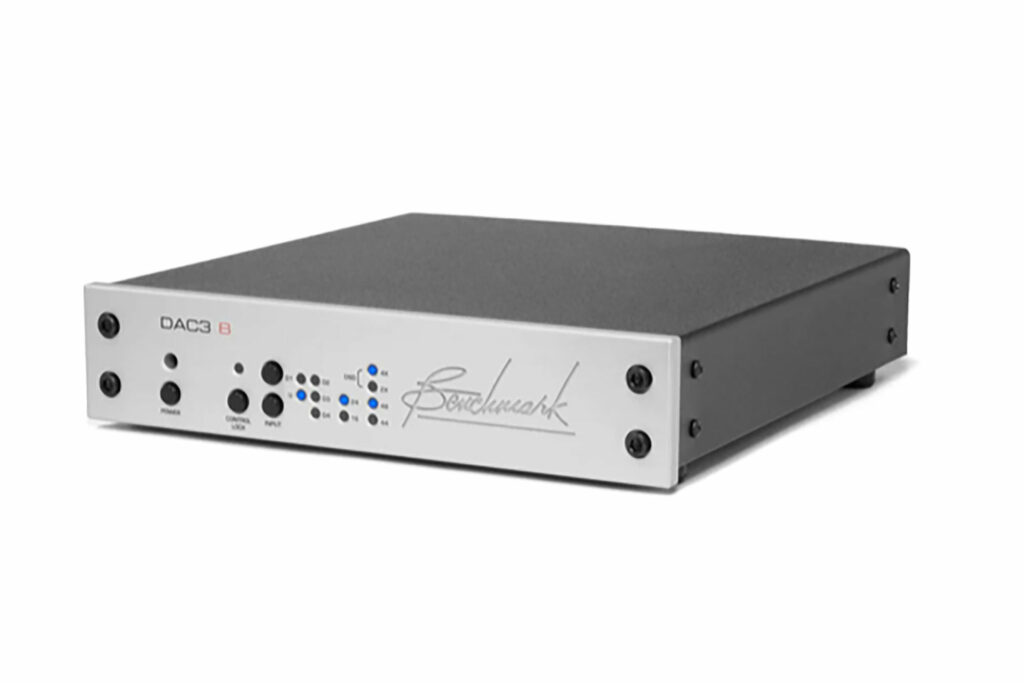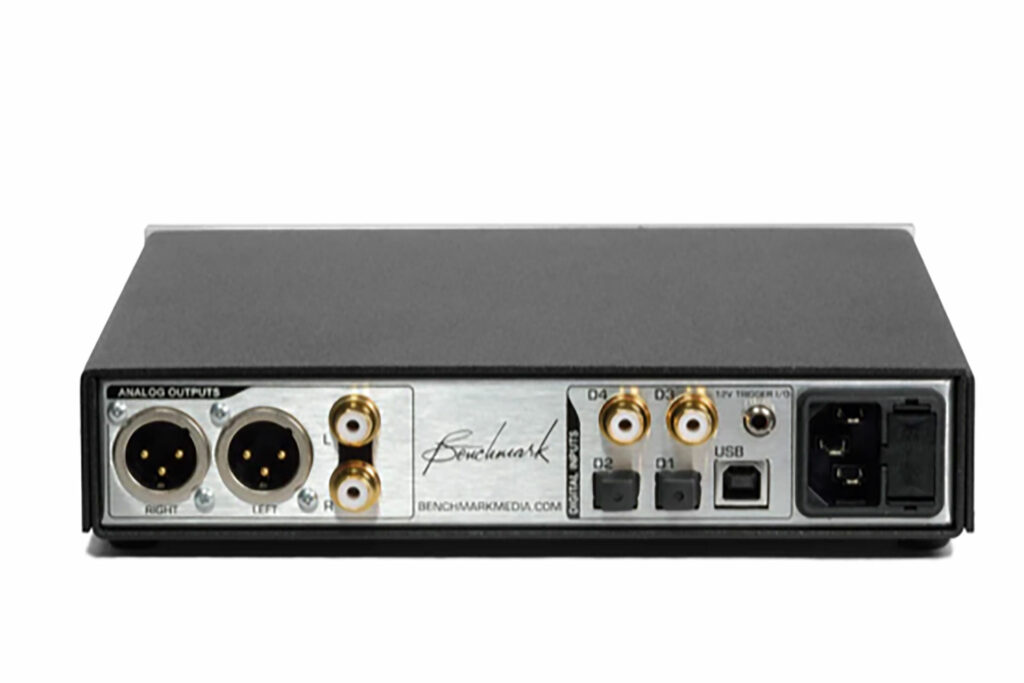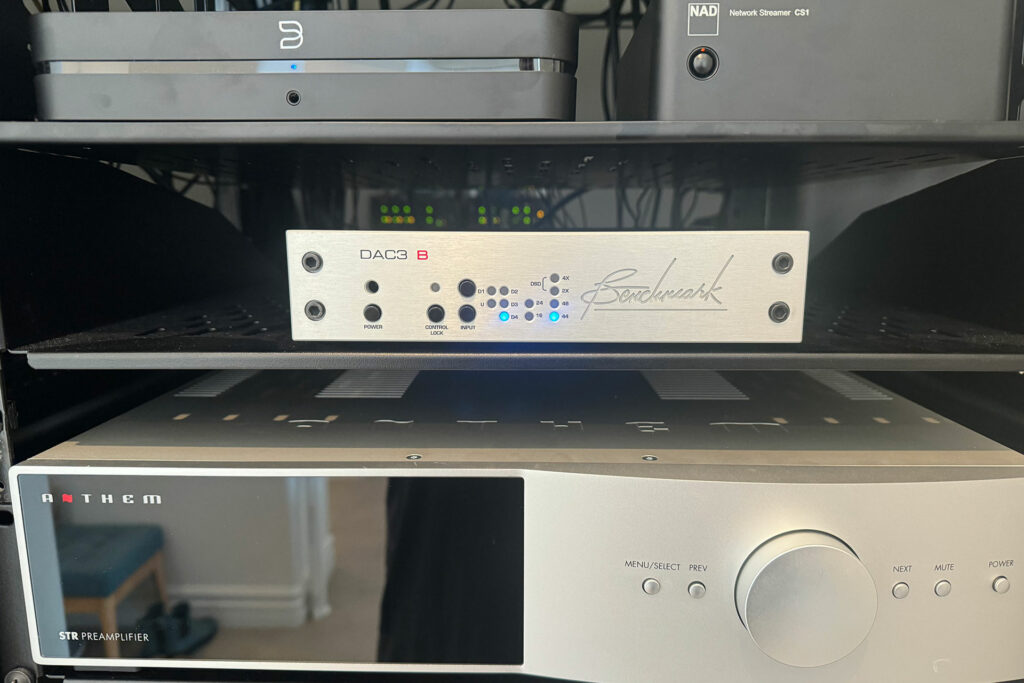Audiophiles today have more and more digital music options available to them, thanks to the last of the spinning disc players and countless options in the streamer and/or endpoint market. Many of the above audiophile digital source components come with internal digital to analog conversion, and some of them come with pretty good ones at that. For those who are looking for the next level of resolution and for those who want to get, specifically, as close to the master recording as possible, they look to companies like Benchmark Media. Benchmark is a stalwart brand in pro audio, but has carved out a very respectable niche in the audiophile world with their diminutive but powerful components.
The Benchmark Media DAC3 B (buy at Amazon) is their least expensive component at $1,899, but it represents their current best-performing DAC. Michael Zisserson reviewed their DAC/preamp version of this component, called the Benchmark DAC3 HCG which is only $2,395 (read the review here). This unit allows more inputs, as well as volume control, yet comes with the same digital section that is found in the Benchmark DAC3 B. For those audiophiles who have a full-function stereo preamp, the Benchmark DAC3 B is a more affordable, studio-grade DAC that is a no-nonsense and no-bullshit component. It is very WYSIWYG sonically, which can be both enlightening and a little scary at the same time. We got one to spend some time with, and we’ve given it a run for its money. Here’s what we learned…

What Makes the Benchmark DAC3 B So Special?
- This is a small form-factor audiophile component, but they pack a lot of pretty advanced technology into a half-rack space width unit. The Benchmark is designed to mount into a professional equipment rack, and can come with rack ears or sit on a shelf. I sat it on a shelf so to be close in proximity to the various streamers and endpoints that we are testing in early 2024.
- The UltraLock3 Jitter Attenuation System improves the time from 400 micro-seconds to a mere six pico-seconds (ps). The DAC performs in the 32-bit range, thus leaves digital room your 16- to 24-bit digital sources with many more overall bits. The sample rate is 211 kHz, which reportedly renders jitter gone. They say that the sound of any jitter is 140 dB below the level of the music. That’s pretty far away, and jitter can sound kinda nasty as part of overall digital nastiness. “Upconverting” does not necessarily remove jitter, but it can if it is done properly. The Benchmark DAC3 includes a digital PLL that reduces jitter-induced distortion to levels that are well below the threshold of hearing. Jitter-induced distortion is 140 dB below the level of the music, meaning that it will be well below the 0 dB SPL threshold of hearing. In most systems, the jitter-induced distortion will be about 25 dB below the threshold of hearing. In other words, absolutely inaudible in an otherwise perfectly quiet room.
- The Benchmark DAC3 B uses an eight-channel ESS DAC chip for two channel conversion. The ESS chip contains eight fully balanced 32-bit DACs. Each DAC3 output channel is driven by four DACs wired in parallel. This 4:1 parallel structure reduces the converter noise by 6 dB.Benchmark Media reports a massive six dB improvement in noise when using four DACs, versus a more traditional, one-DAC solution.
- There is a Control Lock feature that can permanently set the output of the DAC. In a world where there are all sorts of features and options for music in HD that comes from your laptop or any number of devices, this allows you to not have any unexpected issues with your streaming or files, such as truncating or down-converting any of your music. I can see how this is a must-have in the studio, but it also has its benefits in a modern audiophile system.
- The Benchmark uses a pretty solid but small power supply and thankfully doesn’t draw much power from the wall, as you will see with other audiophile components.
- There are five inputs on the Benchmark DAC3 B, including one USB, two Optical and two COAX. There are both balanced and unbalanced analog outputs, thus your input and output needs are pretty well covered.
- Under the hood, the Benchmark DAC works in a multi-mode Asynchronous USB system. Again, the engineers at Benchmark are looking to attack digital jitter as the enemy. They add more buffer and a multi-layered approach to how they take in sources from standard CD- (or lower-) level 16-bit signals, up to 24/192 bleeding-edge digital. This system works well in the MAC OS (for professional users), as well as supporting DSD files, which audiophiles will think is great.
- For those who are connoisseurs of DAC chips and semiconductors, the Benchmark DAC3 B uses the ESS 9028PRO. There are those who get into this level of parts study, but you can’t listen to a DAC chip as much as the finished product. ESS is a fine maker of semiconductors, especially for audiophile DACs, which is a big part (but not the only reason) of why the Benchmark DAC3 B sounds the way that it does.
Why Should You Care About the Benchmark DAC3 B?
The audiophile who is interested in the Benchmark Media DAC3 B is looking to get as close to the master recording as possible. He or she is looking to use the same type of gear that so many professionals use in the studio. This is the audio analogy of driving a Lamborghini around town. You are going to feel every crack in the road, as well as every speed bump. In the Benchmark DAC3 B, there’s no filtering. There’s no EQ. When your recordings are beautiful, they will sound really great on the Benchmark Media DAC3 B. When they are less than gorgeous, you will hear the flaws, be they from the source device or the streaming service. Some audiophile components offer filtering and other ways to make things sound a little more safe or warm. That’s not how the Benchmark rolls, thus why it is used in their top-level system as their most resolute and capable DAC at a price that is far lower than many high-end DACs in the audiophile world today.

Some Things You Might Not Like About the Benchmark Media DAC3 B
- This is a killer DAC, but it isn’t going to hide anything from you sonically. If you’ve got issues in your system, such as weak source components or problems with your streaming, you will hear it through the Benchmark DAC3 B. I could have just as easily listed this as something that makes the Benchmark DAC3 B special/positive in the above section, but this is often what some audiophiles don’t like about the Benchmark. Think about the movie quote “You can’t handle the truth!” for those folks. You need to be dedicated to hearing what the artists, engineers and producers want you to hear in your system to be into the Benchmark. Count me as one of those listeners, as I don’t need EQ, filtering or coloration from an external DAC.
- The small size of the Benchmark DAC3 B doesn’t affect performance, but it does make it somewhat physically awkward, compared to more traditional, 17-inch-wide audiophile components. I know listening to a component is different (and far more important) than looking at it, but this DAC is not likely anywhere as big as your stereo preamp, if that matters to you.
- There is a remote that comes with the unit, but it is plasticky and not backlit. I didn’t use the factory remote at all, as I easily could switch inputs on the front of the unit and just leave it there. Most of my switching happens in my Anthem STR stereo preamp. For those who switch digital inputs a lot, the remote is a good thing, but the remote is a bit chintzy when the component itself is anything but cheap or flimsy.
Listening to the Benchmark Media DAC3 B…
I’ve been listening more and more to my audiophile system with my wife, who has been exposed to all of my past system configurations, but only recently started to realize that our limited alone-time at night is spent listening to music, versus watching news pundits yammer. My current system has a number of streamers and endpoints in it, including a Sonos Port, an NAD CS-1 endpoint and a BlueSound Note. I am using an Anthem STR stereo preamp (buy at Crutchfield) with a Pass Labs XA-25 class-A power amp connected to Bowers & Wilkins 802 D4 speakers. I’ve had a few pretty slick components come and go recently, including the Pass Labs XP-22 stereo preamp, which I miss pretty badly. The system is solid overall, and I am having a blast plugging in new and exciting audiophile components, despite the fact that my room acoustics and actual physics are less than optimal. Sadly, that’s just not something that I can deal with.
If you were looking for albums that made the Mt. Rushmore of Audiophile Music, you would have to give serious consideration to Fleetwood Mac’s Rumours album. The song “Gold Dust Woman” is my go-to demo track on this all-time classic, genre-defining album. What was stunning to hear was how different the sources sounded when plugged into the Benchmark DAC, as these sources aren’t all created equally. The Sonos Port is limited to 16-bit CD quality sound, and the unit’s internal DAC is voiced to make that component sound pretty good on its own, meaning no external DAC. With the Benchmark in the mix via a COAX input, you could hear the limitations of the streaming via Amazon, as their HD track simply isn’t in HD. When you switch over to the Bluesound Node and level-match the sources, you get a far more detailed and open sound. Sonic imaging pops more in front and outside of the boundaries of the speakers. The twangy details of the flanged guitar sound more compelling and engaging. They have more of that in-the-studio sound. On the NAD CS-1 endpoint, the same track from the same source just wasn’t quite as involving. It was good, don’t get me wrong. In fact, is was totally respectable, but with the Benchmark DAC3 B in the loop, you could hear much more of what was on the recording.
Moving to a modern-day audiophile classic, I cued up Marcin’s innovative, percussive, acoustic guitar (and bass and some electronic production) cover of Led Zeppelin’s anthem, Kashmir. Part Eddie Van Halen two-handed tapping and part bongo drummer who just found an acoustic guitar in the dumpster, Marcin brings a very familiar melody to audiophiles in a gorgeous recording. When piping this into my system via the Bluesound Node, I felt like the bass was a bit tighter. The attack on the slaps to his acoustic guitar had a little bit more of that visceral slam that I heard when I listened to this track in Boulder’s incredible reference room with some older but large-scale Focal speakers. With the Benchmark DAC3 B in the loop, I could hear little details more than any “ah-ha moment” that we often seek in the audiophile world. The Benchmark DAC3 B took the goodies that it was being fed and ran with it in a way that had WOW written all over it.
The new Peter Gabriel album i/o is a new release (in various mixes such as this Bright-Side version). Normally, modern Peter Gabriel solo records have a somewhat flat, overly-produced or processed sound to them, dating back to the iconic SO album, which is still a personal favorite. The track “The Court (Bright-Side Mix)” is a pretty familiar Gabriel sonic formula, but what I couldn’t help noting was how wonderfully layered and detailed this track sounded from Amazon Music in HD. The piano had space and air around it. The overdubbed Gabriel vocals at the start of the song are carefully pieced together and sounded great. The bass was tight, as you would expect, while the percussive instruments added all sorts of interesting things to listen to in this engaging mix. This is a good example of hearing what’s on the record, but not coloring or modifying it. If you played a 1983 Dead Kennedys record through the Benchmark DAC3 B, you wouldn’t get the same audiophile-tastic results, which is easy to understand, as you are hearing what is in the recording more than trying to fix lesser musical examples.
Will the Benchmark DAC3 B Hold Its Value?
Not only is the Benchmark DAC3 B a known entity in the audiophile world, there are thousands of studios worldwide that could use such a DAC, thus resale is likely going to be strong in the coming years. This is an advanced digital component capable of giving you an unrivaled view into the world of any number of sources of recorded music. Also, the low overall retail price makes it so that the Benchmark DAC3 B will be a strong player even in the future, when new digital audio technologies emerge. The short version is – your investment is pretty damn safe here, friends.
What is the Competition for the Benchmark DAC3 B?
There are so many external DACs that could make this list. The PS Audio StellarGold DAC at $3,995 comes to mind. This newly-released DAC also uses four parallel DACs in its design. The new PS Audio, as well as its twice-the-price brother, the $7,999 PS Audio DirectStream DAC 2 (reviewed by Paul Wilson), is also a very resolved and revealing DAC. Again, this is a DAC for people who want to hear the music on the recording over masking any possible digital issues that could happening upstream. The PS Audio StellarGold DAC is a more traditional yet slim form factor, versus a half-rack (17 inches wide) format, which might be more appealing to audiophiles, as it is more standardized in its format.
You might think that I’ve lost my mind a bit to put a $10,500 Meitner DAC into the comparison, but the Meitner MA3 DAC is another all-star designed digital-to-analog converter from north of the border that has deep pro audio roots. Paul Wilson was able to review this full-sized DAC and it wooed him with its remarkably resolved sound. Yes, it is five times more than the Benchmark, and that compliment is very much intended, as many consider the Benchmark to be that level of value.
Schiit Yggdrasil+ OG DAC is $2,700. Jason and his team at Schiit are not just a bunch of jokesters (you gotta love that with them), but they are known for making products that are stripped down to the very essence of a component. Like the Benchmark line, Schiit products are absolutely no-nonsense. Again, this another DAC using four Texas Instruments DAC chips. The analog stage is reportedly fully Class-A. It has a good upgrade path, which helps protect your investment, like PS Audio has done. This is a very solid, no-bullshit DAC that can hang with a Benchmark DAC3 B at around the same price.

Final Thoughts on the Benchmark DAC3 B Audiophile DAC…
The audiophile world sometimes looks to the professional audio world for enlightenment, especially on the digital side of things, and Benchmark Media is one of the companies that we put high on a pedestal. They are hardcore digital engineers freezing their asses off in upstate New York as they come up with some pretty innovative ways to get your varied digital sources sounding as much like the master tape as possible. Thank you for your service, gentlemen.
If you are looking for kind of cushy sound that is the audiophile equivalent of a Crown Victoria (non-police cruiser version, of course), this isn’t your DAC. In that case, one might want a DAC with a tube in the analog stage, and yes, that is actually a thing. If you are like me, and you aim to get that in-the-studio, immediate, visceral, detailed, three-dimensional sound that so few audiophile systems can accomplish, then a little under $2,000 might be needed to get invested for you to hear the Benchmark DAC3 B. They sell the unit direct, and it is an easy item for you to audition, because of its waif-like weight and diminutive size. You won’t find Benchmark in a lot of audiophile dealers, because they sell with slim pro audio margins, thus aren’t as profitable as other brands to sell, but that’s likely not your concern. If you really want to hear what your music sounds like in today’s streaming-driven world, this might just be the DAC that you need to test out.




I’m saving this in my notebook of quotable audiophile jargon:
“If you are looking for kind of cushy sound that is the audiophile equivalent of a Crown Victoria (non-police cruiser version, of course), this isn’t your DAC”.
Seriously though Jerry, thanks for another great review!
My Benchmark DAC1 Pre has a heavy remote handset with an all-metal chassis, so I’m disappointed they’ve cheaped out on the remote for this version. But I would hardly use it anyway. Hoping it will fit in my DAC1 rack tray though.
I own a Benchmark DAC3 B and I don’t use the remote.
I would assume most don’t which is why they don’t put an uber-fancy one on there.
There are other ways that you could control your Benchmark if you wanted to look at another remote. I use Crestron Home. Control4 is more affordable. There are other universal remotes that are doable too.
Thanks for your comments.